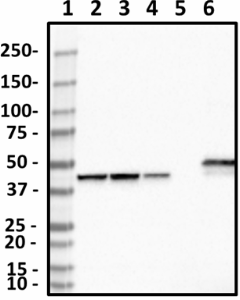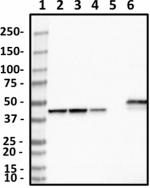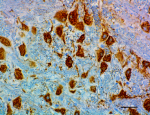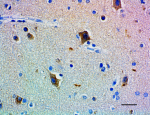- Clone
- 1A6-C7-G10 (See other available formats)
- Regulatory Status
- RUO
- Other Names
- CKMT1A, CKMT1B, Creatine Kinase, Mitochondrial 1A
- Isotype
- Mouse IgG1, κ
- Ave. Rating
- Submit a Review
- Product Citations
- publications

-

Western blot of purified anti-CKMT1 antibody (clone 1A6-C7-G10). Lane 1: Molecular weight marker; Lane 2: 20 µg of human brain lysate; Lane 3: 20 µg of mouse brain lysate; Lane 4: 20 µg of rat brain lysate; Lane 5: 10 ng of recombinant human CKMT2 protein; Lane 6: 10 µg of CKMT1A overexpression lysate. The blot was incubated with 2 µg/mL of the primary antibody overnight at 4°C, followed by incubation with HRP-labeled goat anti-mouse IgG (Cat. No. 405306). Enhanced chemiluminescence was used as the detection system. -

IHC staining of purified anti-CKMT1 antibody (clone 1A6-C7-G10) on formalin-fixed paraffin-embedded mouse brain tissue. Following antigen retrieval using Sodium Citrate H.I.E.R. (Cat. No. 928502), the tissue was incubated with 2 µg/ml of the primary antibody overnight at 4°C. BioLegend's Ultra Streptavidin (USA) HRP Detection Kit (Multi-Species, DAB, Cat. No. 929901) was used for detection followed by hematoxylin counterstaining, according to the protocol provided. The image was captured with a 40X objective. Scale Bar: 50 µm -

IHC staining of purified anti-CKMT1 antibody (clone 1A6-C7-G10) on formalin-fixed paraffin-embedded rat brain tissue. Following antigen retrieval using Sodium Citrate H.I.E.R. (Cat. No. 928502), the tissue was incubated with 2 µg/ml of the primary antibody overnight at 4°C. BioLegend's Ultra Streptavidin (USA) HRP Detection Kit (Multi-Species, DAB, Cat. No. 929901) was used for detection followed by hematoxylin counterstaining, according to the protocol provided. The image was captured with a 40X objective. Scale Bar: 50 µm -

IHC staining of purified anti-CKMT1 antibody (clone 1A6-C7-G10) on formalin-fixed paraffin-embedded human brain tissue. Following antigen retrieval using Sodium Citrate H.I.E.R. (Cat. No. 928502), the tissue was incubated with 2 µg/ml of the primary antibody overnight at 4°C. BioLegend's Ultra Streptavidin (USA) HRP Detection Kit (Multi-Species, DAB, Cat. No. 929901) was used for detection followed by hematoxylin counterstaining, according to the protocol provided. The image was captured with a 40X objective. Scale Bar: 50 µm -

ICC staining of purified anti-CKMT1 antibody (clone 1A6-C7-G10) on SH-SY5Y Cells. The cells were fixed with 4% PFA, permeabilized with a buffer containing 0.1% Triton X-100 and 0.25% BSA, and blocked with 2% normal goat serum and 0.02% BSA. The cells were then incubated with 10 µg/mL of the primary antibody overnight at 4°C, followed by incubation with 2.5 µg/mL of Alexa Fluor® 594 goat anti-mouse IgG for one hour at room temperature. The cells were co-stained with Flash Phalloidin™ Green 488 (Cat. No. 424201). The slide was mounted with fluoromount G with DAPI. The image was captured with a 60X objective. Scale bar: 20 µm
| Cat # | Size | Price | Quantity Check Availability | Save | ||
|---|---|---|---|---|---|---|
| 867201 | 25 µg | £73 | ||||
| 867202 | 100 µg | £189 | ||||
CKMT1 is the mitochondrial specific creatine kinase subunit that is ubiquitously expressed in mammals. CKMT1 is mainly localized to the mitochondrial intermembrane space and plays an important role in cellular energetics. Impairment in CKMT1 due to oxidative and radical-induced damage has been reported in numerous diseases including neurodegenerative disorders. Overexpression of CKMT1 is observed in several tumors in which high energy consumption is required for proliferation.
Product DetailsProduct Details
- Verified Reactivity
- Human, Mouse, Rat
- Antibody Type
- Monoclonal
- Host Species
- Mouse
- Immunogen
- Purified recombinant human CKMT1 fragment expressed in E. coli.
- Formulation
- Phosphate-buffered solution, pH 7.2, containing 0.09% sodium azide.
- Preparation
- The antibody was purified by affinity chromatography.
- Concentration
- 0.5 mg/mL
- Storage & Handling
- The antibody solution should be stored undiluted between 2°C and 8°C.
- Application
-
WB - Quality tested
IHC-P, ICC - Verified - Recommended Usage
-
Each lot of this antibody is quality control tested by Western blotting. For Western blotting, the suggested use of this reagent is 0.5 - 10 µg per mL. For immunohistochemistry on formalin-fixed paraffin-embedded tissue sections, a concentration range of 2.0 - 10 µg/mL is suggested. For immunocytochemistry, a concentration range of 2.0 - 10 μg/mL is recommended. It is recommended that the reagent be titrated for optimal performance for each application.
- Product Citations
-
- RRID
-
AB_2810799 (BioLegend Cat. No. 867201)
AB_2810800 (BioLegend Cat. No. 867202)
Antigen Details
- Structure
- CKMT1 is a 417 amino acid protein with predicted and observed molecular mass of ~47 kD.
- Distribution
-
Tissue Distribution: Mainly expressed in brain, appendix, tonsil, skin, and colon
Cellular Distribution: Mitochondrion and cytosol - Function
- CKMT1 plays a central role in energy transduction in tissues with large, fluctuating energy demands such as the brain.
- Interaction
- CKMT1 exists as an octamer composed of four homodimers
- Cell Type
- Neurons
- Biology Area
- Cancer Biomarkers, Cell Death, Neurodegeneration, Neuroinflammation, Neuroscience
- Molecular Family
- Mitochondrial Markers
- Antigen References
-
- Gramage E, et al. 2013. Toxicology. 10.1016/j.tox.2013.02.013.
- Tanimura A, et al. 2014. PLoS One. 9(2):e89916.
- Onda T, et al. 2006. Br J Cancer. 94:698-709.
- Gene ID
- 1159 View all products for this Gene ID 12716 View all products for this Gene ID 29593 View all products for this Gene ID
- UniProt
- View information about CKMT1 on UniProt.org
Related FAQs
Other Formats
View All CKMT1 Reagents Request Custom Conjugation| Description | Clone | Applications |
|---|---|---|
| Purified anti-CKMT1 | 1A6-C7-G10 | WB,IHC-P,ICC |
Compare Data Across All Formats
This data display is provided for general comparisons between formats.
Your actual data may vary due to variations in samples, target cells, instruments and their settings, staining conditions, and other factors.
If you need assistance with selecting the best format contact our expert technical support team.
-
Purified anti-CKMT1

Western blot of purified anti-CKMT1 antibody (clone 1A6-C7-G... 
IHC staining of purified anti-CKMT1 antibody (clone 1A6-C7-G... 
IHC staining of purified anti-CKMT1 antibody (clone 1A6-C7-G... 
IHC staining of purified anti-CKMT1 antibody (clone 1A6-C7-G... 
ICC staining of purified anti-CKMT1 antibody (clone 1A6-C7-G...
 Login / Register
Login / Register 







Follow Us